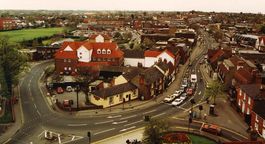Rayleigh, Essex
| Rayleigh | |
|---|---|
 |
|
| Rayleigh shown within Essex | |
| Population | 32,150 (2011) |
| OS grid reference | TQ805907 |
| District | |
| Shire county | |
| Region | |
| Country | England |
| Sovereign state | United Kingdom |
| Post town | RAYLEIGH |
| Postcode district | SS6 |
| Dialling code | 01268 |
| Police | Essex |
| Fire | Essex |
| Ambulance | East of England |
| EU Parliament | East of England |
| UK Parliament | |
Rayleigh /ˈreɪliː/ is a market town and civil parish in the District of Rochford in Essex, England, located between Chelmsford and Southend-on-Sea. It lies 32 miles (51 km) to the east of central London. It had a population of 30,196 in 2001, increasing to 32,150 at the census 2011.
The name "Rayleigh" is Saxon in origin and is cognate to the German place name Rehlach of the same meaning . According to the English Place Names Society, "Rayleigh" derives from "raege", and "leah", meaning "Female roe-deer stream" or "she-goat stream" . According to the Rayleigh Civic Society, "Roa" is a Saxon word for Roebuck and "Lea" a pasture probably for goats.
In any case, the connection with deer continued through the centuries. Lands around Rayleigh were used as royal hunting forests for many hundreds of years. A deer was included in the coat of arms of Rayleigh Urban District Council, and in the early 2000s, a new pub was named the "Roebuck".
There have been a scattering of stray finds around the town from Prehistoric and Roman times, including some Roman roof and hypocaust tiles found within the fabric of Rayleigh Church. This suggests there was a Roman habitation site within the area. However, there is little evidence of any density of population here during this period.
One significant archaeological find was in the early 2000s at the western edge of Rayleigh, at the site of the former Park School in Rawreth Lane. An early Saxon cemetery site was discovered here, with 144 cremation burials and evidence of just one high-status female inhumation burial.
By the end of the Saxon period, there was definitely a village here, as it is recorded in the Domesday Book, when it was held by Swein of Essex, the son of Robert FitzWimarc.
The most significant historic monument in Rayleigh is the great medieval mound of Rayleigh Castle. This was an early Norman motte and bailey castle, of which only the motte and its surrounding embankments remain. Despite the loss of its timber superstructure and later stone buildings, its height and bulk mean that it still dominates the town centre.
...
Wikipedia

